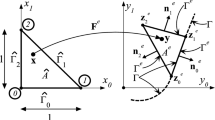Abstract
Reflection of a bundle of coherent light on the warped cross section of a prismatic bar submitted to torsion forms a caustic on a receiver plane. From the mathematical expression of this curve and the theory of reflected caustics, it is possible to evaluate accurately the warping function of the cross section. Using this idea, it was possible to study the torsion problem in prismatic bars with sections which were equilateral triangles and squares. It was observed that the shape of the caustic is an hypocycloid curve with three or four cusps respectively. By evaluating the warping function by using elements from the respective caustics it was possible to find out that, for the triangular cross section, the expression for the warping function coincided exactly with the expression given by the exact solution of the problem. For the square cross section, a closed-form solution for its warping function was readily derived, to which the series approximation solution differed only by a few percent at maximum for the shear stresses.
Since the method can be readily extended to any canonical polygonic cross section, it constitutes a general solution for the torsion of prismatic bars, which approximates their exact deformations better than the solutions based on the Saint-Vénant assumptions.
Similar content being viewed by others
References
Coulomb, C.A., “Histoire de l'Académie,” Paris, 229–269 (1787).
Navier, C.L., “Resumé des leçons sur l'application de la mécanique,” 3rd Ed., Paris (1864).
Saint-Vénant, B., “Mémoire sur la torsion des Prismes,”Mémoires presentés par divers savants à l'Académie des Sciences (Sect. Mathématiques et Physiques),14,233–560 (1855).
Frocht, M.M., Photoelasticity, John Wiley and Sons, New York,II,418 (1941).
Horgan, C.O. andKnowles, J.K., “Recent Development Concerning Saint-Vénant's Principle,” ADVANCES IN APPLIED MECHANICS,Academic Press Inc.,23,179–269 (1983).
Prandtl, L., “Zur torsion von prismatischen Staeben,”Physik. Zeitsch.,4,758–770 (1903).
Timoshenko, S. andGoodier, J., Theory of Elasticity, McGraw-Hill Book Co., New York (1970).
Theocaris, P.S., “Mechanics of Fracture,”ed. G.C. Sih, Nijhoff Publ.,7,Chap. 3,189–252 (1981).
Theocaris, P.S. andPetrou, L., “The Reflected Caustics Formed from Cross Sections of Twisted Prismatic Bars,”Act. Mech.,66 (1),21–38 (1988).
Sokolnikoff, J.S., “Mathematical Theory of Elasticity”McGraw-Hill, New York, 107–137 (1956).
Theocaris, P.S., “Multicusp Caustics Formed from Reflections of Warped Surfaces,”Appl. Opt.,27 (4),780–789 (1988).
Theocaris, P.S., “From the Rectangular Hole to the Ideal Crack,”Int. J. Sol. and Struct.,25 (3),213–233 (1989).
Theocaris, P.S. andPetrou, L., “The Order of Singulaity and the SIF near Corners of Regular Polygonal Holes,”Int. J. Eng. Sci.,25 (7),821–832 (1987).
Author information
Authors and Affiliations
Rights and permissions
About this article
Cite this article
Theocaris, P.S. The warping functions of regular prismatic bars under torsion evaluated by caustics. Experimental Mechanics 29, 285–290 (1989). https://doi.org/10.1007/BF02321409
Received:
Revised:
Issue Date:
DOI: https://doi.org/10.1007/BF02321409




